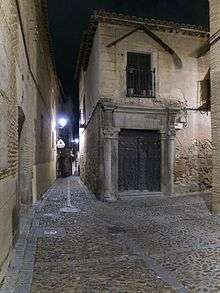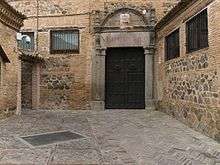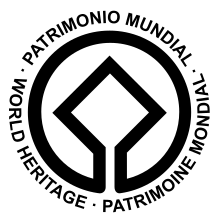Jewish quarter of Toledo


The Jewish quarter of Toledo is a district of the city of Toledo, in Castile-La Mancha, Spain. It was the neighborhood in which the Jews lived in the Middle Ages, although they were not obliged to live within it.
It is the Jewish community of Toledo which became, in the 12th and 13th centuries, the most populous and rich of the Kingdom of Castile. And coexists for centuries, more or less peacefully, with Muslims and Christians, in which it would be called city of the three cultures. [1]
Description
The quarter can be reached through a gate. One of the many entrances is the gate Puerta de Assulca, which has in its vicinity in flea market where oil, butter, chickpeas, lentils and everything necessary for daily life are sold.
Then it enters the streets, adarves (dead-end streets) and squares of the quarter. The main street is called Calle del Mármol and connects the Jewish quarter with the rest of the city.
There is a market, places to pray, public baths, bread ovens, palaces and a wall. Near the Tagus river is the neighborhood Barrio del Degolladero, so named because here was the carnage-slaughter where the cattle was sacrificed according to the Jewish ritual.
In the neighborhood Barrio de Hamazelt the richest Jewish families lived and in the street known today as San Juan de Dios, lived the best known Jew of Toledo: Samuel ha-Levi. He was the treasurer of the king Peter of Castile and ordered to build a big synagogue, that later was known like "Synagogue of El Transito". And like in all the Jewish houses, also in his one there is a mezuzah with the scriptures that serves to protect the home.
The place of prayer of the Jews is the synagogue and today it is conserved the one of Santa María la Blanca and the one of El Tránsito. Before, every Friday at sunrise, a rabbi sounded three times the sofar (a goat's horn) announcing the arrival of the Sabbath, a holiday for the Jews, who rested while the rest of the city continued with its usual bustl.
Near each synagogue there is an underground bath called mikveh. The Jews came here to purify themselves on different occasions, for example after healing from a wound or a serious illness, women before getting married or even to wash the dishes that are used at the feast of Passover.
References
- ↑ saltaconmigo.com. "VISITA A LA JUDERÍA DE TOLEDO: LA MÁS IMPORTANTE DE ESPAÑA".

